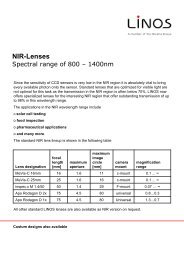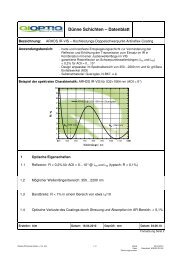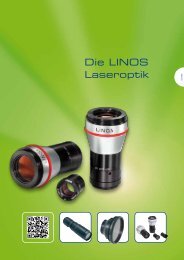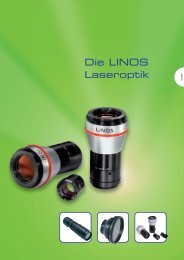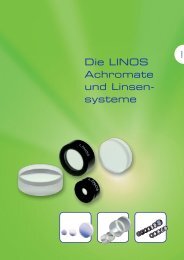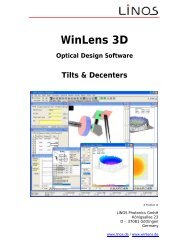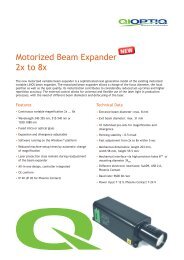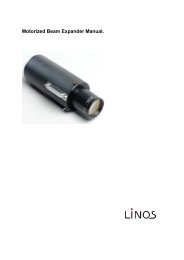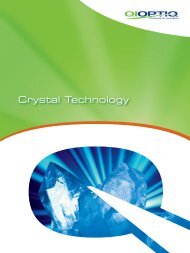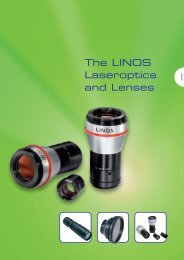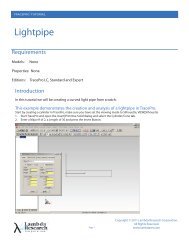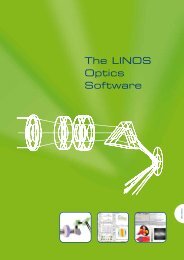08-Optical Tables.pdf - Qioptiq Q-Shop
08-Optical Tables.pdf - Qioptiq Q-Shop
08-Optical Tables.pdf - Qioptiq Q-Shop
Create successful ePaper yourself
Turn your PDF publications into a flip-book with our unique Google optimized e-Paper software.
Microbench Nanobench Tube System C Positioners Rail Systems Mounts and Posts Mirror Mounts<br />
Strong Internal Damping<br />
Table tops exhibit strong internal<br />
damping that both minimizes their<br />
response to external shocks and vibrations<br />
and dissipates the energies of any<br />
activated vibrational modes of their top<br />
plates. The internal dam-ping characteristics<br />
of Table Tops are particularly critical<br />
in cases where they are supported on<br />
vibration-isolation systems.<br />
Many manufacturers use viscoelastic<br />
adhesives to attach top and bottom<br />
plates to honeycomb cores, a practice<br />
that substantially reduces the stiffnesses<br />
of final Table Top structures. All epoxy<br />
resins used by TMC are hard-setting and<br />
supplemented by dam ping masses. This<br />
approach eliminates both aging effect<br />
and outgassing. The damping characteristics<br />
of our Table Tops are individually<br />
tuned to their structural resonan ces.<br />
TMC‘s firm adherence to these design<br />
prin ci ples in manufacturing its <strong>Optical</strong><br />
Table Tops results in superior-quality<br />
Table Tops exhibiting stiffness that has<br />
yet to be equalled. Their low compliances,<br />
the recipro cals of their dynamic<br />
rigidities, are readily evident from their<br />
corner-compliance curves.<br />
TMC offers three levels of damping:<br />
Maximum damping:<br />
For holography, interferometry, spectroskopy,<br />
also recommended in particularly<br />
noisy vibration and for puldes lasers.<br />
Dry Damping<br />
The damping of the <strong>Optical</strong> Table Tops is<br />
based on a system of broadband dry<br />
damping, which damps all existing<br />
resonances. Dry damping is preferable to<br />
oil-based dampers. Oil‘s characteristics<br />
can change over time and hidden oil<br />
reservoirs are always in danger of being<br />
pierced by an end-user customizing his<br />
system.<br />
An <strong>Optical</strong> Top‘s resonant frequency will<br />
vary based on load, distribution of load,<br />
temperature, and even the presence of<br />
the dampers themselves. Therefore, in<br />
practice, it is difficult to tune the<br />
dampers to the top‘s resonance. The<br />
broadband damping technique is<br />
therefore the most effective way to<br />
damp an <strong>Optical</strong> Top.<br />
Standard damping:<br />
For less sensitive applications. This<br />
broadband damping level provides a top<br />
with performance characteristics that<br />
exceed the majority of other manufacturers‘<br />
highest performance levels.<br />
Nominal damping:<br />
For general lab work when the main<br />
consideration is a rigid, flat mounting<br />
surface.<br />
Frequency (Hz) Frequency (Hz) Frequency (Hz)<br />
We present below the corner-compliance curves for the three damping levels. In this example a table with the dimensions 1200x2400x300 mm is used. To convert from in/lb<br />
to mm/N multiply by a factor of 5.7. Example: 10 -6 in/lb x 5.7 = 5.7 x 10 -6 mm/N.<br />
276 Phone numbers: US +1 585 223 2370 UK +44 2380 744 500 Singapore +65 6499 7766



